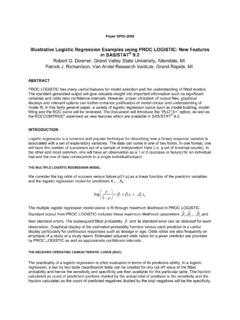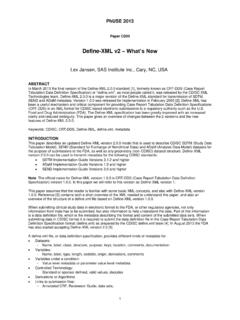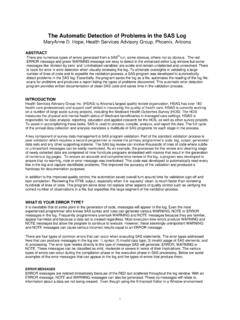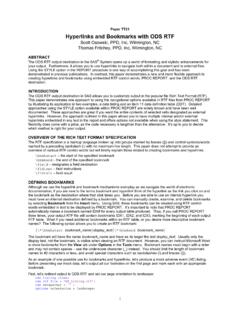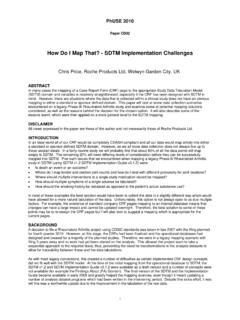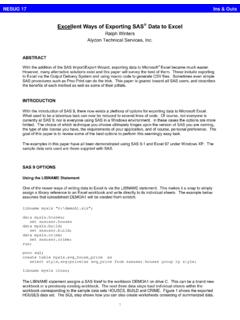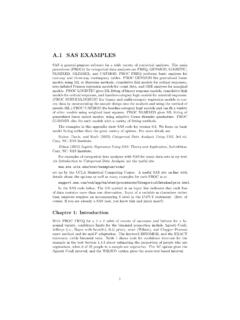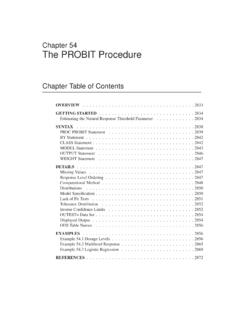Transcription of Using and Understanding LSMEANS and LSMESTIMATE
1 1 Using and Understanding LSMEANS and LSMESTIMATE David J. Pasta, ICON, San Francisco, CA ABSTRACT The concept of least squares means, or population marginal means, seems to confuse a lot of people. We explore least squares means as implemented by the LSMEANS statement in SAS , beginning with the basics. Particular emphasis is paid to the effect of alternative parameterizations (for example, whether binary variables are in the CLASS statement) and the effect of the OBSMARGINS option. We use examples to show how to mimic LSMEANS Using ESTIMATE statements and the advantages of the relatively new LSMESTIMATE statement. The basics of estimability are discussed, including how to get around the dreaded non-estimable messages.
2 Emphasis is put on Using the STORE statement and PROC PLM to test hypotheses without having to redo all the model calculations. This material is appropriate for all levels of SAS experience, but some familiarity with linear models is assumed. INTRODUCTION In a linear model, some of the predictors may be continuous and some may be discrete. A continuous predictor is one for which the numeric values are treated as meaningful and the estimated coefficient is interpreted as the effect of a one-unit change. A discrete (or categorical) predictor is one which is included in the CLASS statement. The individual values are not assumed to have any particular relationship to each other: they are treated as just names for the categories and are not to be interpreted quantitatively even if they are numbers.
3 What is important for our purposes is that we want to estimate the effect of each value separately and not to assume specific spacing between values. In addition, continuous variables can be grouped into categories and converted into discrete variables. This issue is discussed at length in Pasta (2009), but it is worthwhile to summarize a key point made there. Treating an ordinal variable as continuous allows you to estimate the linear component of the relationship, as recommended by Moses et al. (1984). On the other hand, treating an ordinal variable as discrete allows you to capture much more complicated relationships. It seems worthwhile to consider both aspects of the variable.
4 For categorical variables, it is possible to calculate least squares means, also known as population marginal means or adjusted means. These can be thought of as the means for a hypothetical population with a certain distribution of the predictor variables. In the simplest case, with a single categorical predictor, the least squares means are simply the observed sample means for the categories. In a model with a several continuous predictors along with a single categorical predictor, the least squares means are the predicted values for each category under the assumption that the continuous variables are set at fixed values (usually the overall mean of the continuous variable).
5 In more complicated situations with multiple categorical predictors and especially with interactions among categorical predictors, the least squares means can get complicated. Fortunately, SAS provides some convenient tools for Understanding how the least squares means are calculated and some useful ways to work with the least squares means. PARAMETERIZATIONS Before getting into depth about models that include discrete variables, it is necessary to have some Understanding of the way models are parameterized in SAS. This material is covered in numerous places, including several of my papers from previous conferences (Pritchard and Pasta 2004; Pasta 2005; Pasta 2009; Pasta 2010).
6 One parameterization for discrete variables is the less than full rank approach in which dummy variables (indicator variables) are created for each category. This parameterization, also called the GLM parameterization, includes all the dummy variables but recognizes that there are redundancies and uses appropriate computational methods such as generalized inverses to obtain parameter estimates. The last category (as ordered Using the formatted value) ends up as the reference category. To change the reference category it is necessary to reorder the categories of the variable. It is now possible to specify the parameterization you want to use on the CLASS statement (but be aware that which procedures support this approach depends on which version of SAS you are Using ).
7 You can specify REFERENCE coding, which allows you to specify a reference category which is omitted from the design matrix in various convenient ways. Alternatively you can specify EFFECT coding, which effectively compares each category to the overall average rather than to a single category, although there is still an omitted category that you can specify. My experience is that people find EFFECT coding rather confusing at first, so I recommend the use of REFERENCE coding. Note that LOGISTIC now uses EFFECT coding by default. You can specify different coding for different Using and Understanding LSMEANS and LSMESTIMATE 2 variables and different reference categories (the default is LAST), making it much easier to manipulate the parameterization of discrete variables.
8 The examples presented here use GLM parameterization but the principles are all the same. LEAST SQUARES MEANS SOME SIMPLE EXAMPLES Perhaps the simplest example of LSMEANS comes with a single discrete variable. Here s an example (with simulated data). proc glm data=anal; class site; model y4 = site / solution; LSMEANS site / stderr pdiff; LSMEANS site / stderr pdiff OM; title3 "y4 = site with and without OM"; run; Here we have a study with multiple sites and we want to understand how the response variable, Y4, varies across site. We put SITE in the CLASS statement and as the only variable on the right hand side of the model statement.
9 The least squares fit for this linear model is to assign the sample mean to each site. The SOLUTION shows us the estimates for the parameters and the LSMEANS provides the least squares means. The default parameterization, the GLM parameterization, creates a dummy variable for each of the 5 sites but one of the parameters is redundant (the intercept is equal to the sum of the dummy variables for the 5 sites). Therefore the last site is arbitrarily treated as the reference and gets a parameter estimate of 0; the parameters for the other sites are relative to that site. The LSMEANS are easier to understand and, in this case, the least squares means are simply equal to the sample means.
10 The OBSMARGINS or OM option has no effect in this simple example. The STDERR provides the standard error of each LSMEAN and a test of whether that particular LSMEAN is different from zero. This test may or may not be of any interest. The PDIFF option asks for the P value testing whether each possible pairwise difference is statistically significantly different from zero. This is frequently of interest. It should be noted that various methods for adjusting for multiple comparisons are available on the LSMEANS , including the TUKEY method. Here are parts of the output. Source DF Type III SS Mean Square F Value Pr > F site 4 Parameter Estimate Standard Error t Value Pr > |t| Intercept B <.
